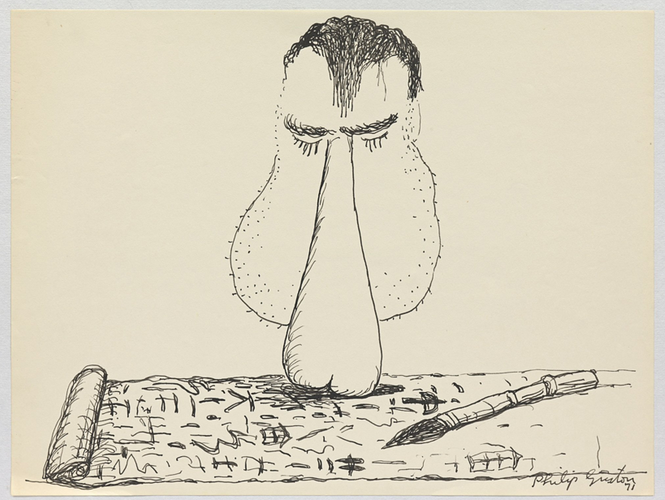After last week’s revelations about the US presidential candidates, none of us probably want to read very much about politics–but here is an interesting bit of political satire from the 1970s. Apparently Philip Guston and Philip Roth lived in Woodstock, New York at the same time in the summer of 1971, and the two became friends and had a ball making fun of Nixon in their respective genres. Guston’s satirical, cartoonish drawings and paintings remind me that we’re in need of a good political satirist/cartoonist these days. Read Charles McGrath on Guston and Roth in partial below, in full via New York Times.
In the summer of 1971, the artist Philip Guston and the writer Philip Roth were refugees of a sort in Woodstock, N.Y. Mr. Roth was fleeing what he called his “overnight notoriety as a sexual freak,” after the publication of “Portnoy’s Complaint.” Guston, in a crisis of self-doubt, was turning his back on practically the entire art world.
Introduced by a mutual acquaintance a couple of years earlier, the two men shared a love of books and of what Guston called “crapola”— billboards, diners, junk shops, burger joints — and Richard M. Nixon was soon added to the list. “He was a shared delight,” Mr. Roth recalled recently. “It wasn’t just the criminal war in Southeast Asia that he was waging but his vile character that aroused the wicked impulse to satire.”
That summer, Mr. Roth began working on what became “Our Gang,” his book-length satire, which begins with the president, Trick E. Dixon, hoping to give the vote to the unborn and ends with him in hell, after being assassinated in a hospital where he had gone to have his sweat glands removed. Mr. Roth showed some early chapters to Guston, who in a mood of shared Nixon-loathing exuberance, responded with a flood of satirical drawings. In a couple of them Guston’s Nixon is a hooded Klansman conspiring with his cronies Spiro T. Agnew and John Mitchell, but in most he is a kind of walking gonad, his nose a penis that grows longer with every lie he tells.
On Tuesday, these drawings will be part of a show, “Philip Guston: Laughter in the Dark, Drawings From 1971 & 1975,” opening at the brand-new Hauser & Wirth gallery space on West 22nd Street in Manhattan. It was a last-minute idea, Musa Mayer, Guston’s daughter, said at the gallery last week as she and her co-curator, Sally Radic, of the Guston Foundation, were getting ready to hang the show even as workers were still renovating the space. “The gallery approached me just six weeks ago,” Ms. Mayer said. “I thought, ‘We have to get it up before the election.’” She was thinking in particular of young people, she added, who might not be familiar with Nixon’s history. “I’m hoping the drawings may remind people of what can happen.”
